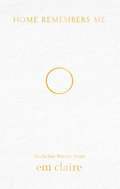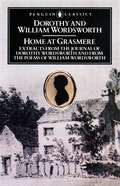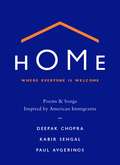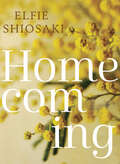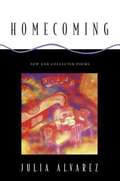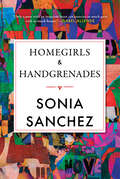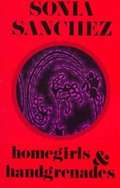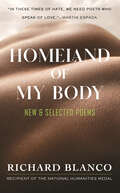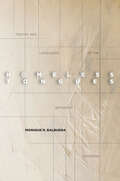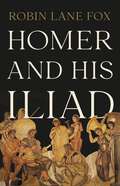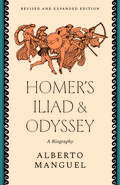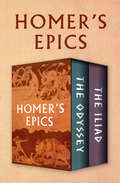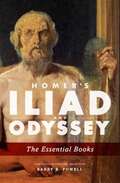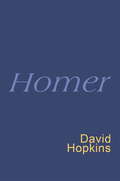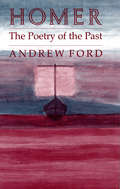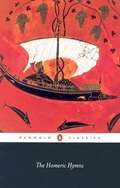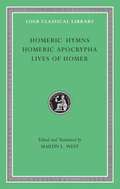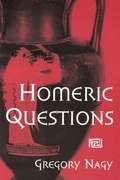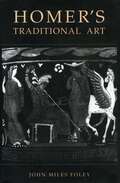- Table View
- List View
Home Remembers Me: Medicine Poems from Em Claire
by Em ClaireHome Remembers Me: Medicine Poems from em claireis a collection of over ninety, awe-inspiring poems selected specifically for anyone in need of comfort, courage, and most of all: hope. Aimed at facilitating deep healing, the poetry offers companionship in times of crisis, taking us by the hand and, poem by poem, leading us out of the darkness and into the light.Silently read or memorized and used as mantra; written down and carried as a personal talisman; given as a gift, or shared aloud, this poetry has been used as medicine, administered from friend to friend, counselor to client, lover to lover, caregiver to hospice patient, clergy to congregation, and shared in retreats and workshops of all kinds, all over the world.
Home at Grasmere: Extracts from the Journal of Dorothy Wordsworth and from the Poems of William Wordsworth
by Dorothy Wordsworth William WordsworthA continuous text made up of extracts from Dorothy Wordsworth's Journal and a selection of her brother's poems. Dorothy Wordsworth kept her Journal 'because I shall give William pleasure by it'. In doing so, she never dreamt that she was giving future readers not only the chance to enjoy her fresh and sensitive delight in the beauties that surrounded her at Grasmere but also a rare opportunity to observe 'the progress of a poet's mind'. Colette Clark's skilful and perceptive arrangement of Dorothy's entries alongside William's poems throws a unique light on his creative process, and shows how the interdependence of brother and sister was a vital part in the writing of many of his great poems. By reading these poems in relation to the Journal it is possible to trace the processes by which they were committed to paper and so achieve a fuller understanding of them. A writer in her own right, Dorothy kept her Journal sparse in personal and emotional detail. Yet there is, nevertheless, a deep emotional undercurrent running beneath the surface which only falters when William marries Mary Hutchinson. Never again was Dorothy to achieve the freedom, spontaneity and the limpidly beautiful prose with which she infused and irradiated the Grasmere Journals.
Home in the Bay
by Kim ShuckFeaturing works by esteemed writers devorah major, Maw Shein Win, Kim Shuck, tiny gray-garcia, Val Vera, Jan Steckel, Arnoldo Garcia, J Spagnolo, Audrey Can-dyCorn, Lisa Ganser, Muteado Silencio, Dee Allen, and more, this anthology brings together pieces shared and inspired by Aunt Lute Books’ Home in the Bay project honoring voices impacted by gentrification, colonization, migration, and homelessness.
Home: Poems & Songs Inspired by American Immigrants
by Deepak Chopra Kabir Sehgal Paul AvgerinosThe United States is composed of and built by immigrants, and it has been a beacon to those in search of a new life for hundreds of years.HOME is a collection of thirty-four poems and twelve songs inspired by a diverse group of immigrants who have made significant contributions to the United States. From Yo-Yo Ma to Audrey Hepburn, Albert Einstein to Celia Cruz, these poems symbolize the many roads that lead to America, and which we expect will continue to converge to build the highways to our future.This unique collaboration takes the form of a keepsake hardcover book, with a CD of beautiful original music tucked inside. An audiobook edition in which Deepak Chopra reads the poems is also available, as a digital download. This hardcover book (with accompanying music CD) and digital-only audiobook will be available simultaneously in September 2017. Offering a welcoming feeling intended to inform our cultural conversation and enhance our national dialogue, HOME has twelve accompanying musical pieces that serve as personal meditations on the essence of home, in which you can reflect upon where you feel most welcome, whether a place or state of mind.Written and composed by immigrants and first generation Americans, HOME provides a stronger sense of welcome and belonging for everyone.
Homecoming: New and Collected Poems
by Julia AlvarezHomecoming was Alvarez's first published collection of poetry, a work of great subtlety and power in which the young poet returned to her old-world childhood in the Dominican Republic.
Homegirls & Handgrenades
by Sonia SanchezWinner of the American Book AwardA classic of the Black Arts Movement brought back to life in a refreshed edition"A lion in literature's forest. When she writes she roars, and when she sleeps other creatures walk gingerly."— Maya AngelouOriginally published in 1984, this collection of prose, prose poems and lyric verses is as fresh and radical today as it was then. Sonia Sanchez, the premiere poet of the Black Arts Movement, shows the &“razor blades&” in clenched in her teeth in these powerful pieces.
Homegirls and Handgrenades
by Sonia SanchezSonia Sanchez's award-winning collection of poems, which contains some of her seminal work and is a winner of the American Book Award.
Homeland of My Body: New and Selected Poems
by Richard BlancoA rich, accomplished, intensely intimate collection with two full sections of new poems bookending Blanco&’s selections from his five previous volumes"An engineer, poet, Cuban American…his poetry bridges cultures and languages—a mosaic of our past, our present, and our future—reflecting a nation that is hectic, colorful, and still becoming."—President Joe Biden, conferring the National Humanities Medal on Richard Blanco, 2023In this collection of over 100 poems, Richard Blanco has carefully selected poems from his previous books that represent his evolution as a writer grappling with his identity, working to find and define &“home,&” and bookended them with new poems that address those issues from a fresh, more mature perspective, allowing him to approach surrendering the pain and urgency of his past explorations. Pausing at this pivotal moment in mid-career, Blanco reexamines his life-long quest to find his proverbial home and all that it encompasses: love, family, identity and ultimately art itself. In the closing section of the volume, he has come to understand and internalize the idea that &“home&” is not one place, not one thing, and lives both inside him and inside his art. The poems range in form, voice, and setting, showcasing his command of craft, but in essence they are one continuous reflection on the existential question at the core of all of Blanco&’s poetry: how can we find our place in the world. All are characterized by his keen eye, deep sensibility, and polished craft, without pretense. This volume is a gift to Blanco&’s many readers but even more to those who have yet to discover that they can understand, and fall in love with poetry, that a poet can speak to them about his own and their own lives so profoundly, and that this poet, as Barack Obama discovered, can speak for all of us.Richard Blanco has been justly celebrated for his poetic gifts and his command of the many forms poetry can take, from the finely structured to the prose poem formats. His previous volumes have been praised by Patricia Smith, Eileen Myles, Sandra Cisneros, Elizabeth Alexander, and many others. His poems have appeared in The New Yorker, The Atlantic, and dozens of other publications.
Homeless Tongues: Poetry and Languages of the Sephardic Diaspora
by Monique BalbuenaThis book examines a group of multicultural Jewish poets to address the issue of multilingualism within a context of minor languages and literatures, nationalism, and diaspora. It introduces three writers working in minor or threatened languages who challenge the usual consensus of Jewish literature: Algerian Sadia Lévy, Israeli Margalit Matitiahu, and Argentine Juan Gelman. Each of them--Lévy in French and Hebrew, Matitiahu in Hebrew and Ladino, and Gelman in Spanish and Ladino--expresses a hybrid or composite Sephardic identity through a strategic choice of competing languages and intertexts. Monique R. Balbuena's close literary readings of their works, which are mostly unknown in the United States, are strongly grounded in their social and historical context. Her focus on contemporary rather than classic Ladino poetry and her argument for the inclusion of Sephardic production in the canon of Jewish literature make Homeless Tongues a timely and unusual intervention.
Homer
by Johannes Haubold Barbara GraziosiThe sixth book of the Iliad includes some of the most memorable and best-loved episodes in the whole poem: it holds meaning and interest for many different people, not just students of ancient Greek. Book 6 describes how Glaukos and Diomedes, though fighting on opposite sides, recognise an ancient bond of hospitality and exchange gifts on the battlefield. It then follows Hector as he enters the city of Troy and meets the most important people in his life: his mother, Helen and Paris, and finally his wife and baby son. It is above all through the loving and fraught encounter between Hector and Andromache that Homer exposes the horror of war. This edition is suitable for undergraduates at all levels, and students in the upper forms of schools. The Introduction requires no knowledge of Greek and is intended for all readers interested in Homer.
Homer
by Irene J. F. De JongBook XXII recounts the climax of the Iliad: the fatal encounter between the main defender of Troy and the greatest warrior of the Greeks, which results in the death of Hector and Achilles' revenge for the death of his friend Patroclus. At the same time it adumbrates Achilles' own death and the fall of Troy. This edition will help students and scholars better appreciate this key part of the epic poem. The introduction summarises central debates in Homeric scholarship, such as the circumstances of composition and the literary interpretation of an oral poem, and offers synoptic discussions of the structure of the Iliad, the role of the narrator, similes and epithets. There is a separate section on language, which provides a compact list of the most frequent Homeric characteristics. The commentary offers up-to-date linguistic guidance, and elucidates narrative techniques, typical elements and central themes.
Homer and His Iliad
by Robin Lane FoxA &“compelling and impressive&” (Sunday Times) reassessment of the Iliad, uncovering how the poem was written and why it remains enduringly powerful The Iliad is the world&’s greatest epic poem—heroic battle and divine fate set against the Trojan War. Its beauty and profound bleakness are intensely moving, but great questions remain: Where, how, and when was it composed and why does it endure? Robin Lane Fox addresses these questions, drawing on a lifelong love and engagement with the poem. He argues for a place, a date, and a method for its composition—subjects of ongoing controversy—combining the detailed expertise of a historian with a poetic reader&’s sensitivity. Lane Fox considers hallmarks of the poem; its values, implicit and explicit; its characters; its women; its gods; and even its horses. Thousands of readers turn to the Iliad every year. Drawing on fifty years of reading and research, Lane Fox offers us a breathtaking tour of this magnificent text, revealing why the poem has endured for ages.
Homer'S Trojan Theater
by Jenny Strauss ClayMoving away from the verbal and thematic repetitions that have dominated Homeric studies and exploiting the insights of cognitive psychology, this highly innovative and accessible study focuses on the visual poetics of the Iliad as the narrative is envisioned by the poet and rendered visible. It does so through a close analysis of the often-neglected 'Battle Books'. They here emerge as a coherently visualized narrative sequence rather than as a random series of combats, and this approach reveals, for instance, the significance of Sarpedon's attack on the Achaean Wall and Patroclus' path to destruction. In addition, Professor Strauss Clay suggests new ways of approaching ancient narratives: not only with one's ear, but also with one's eyes. She further argues that the loci system of mnemonics, usually attributed to Simonides, is already fully exploited by the Iliad poet to keep track of his cast of characters and to organize his narrative.
Homer's "Iliad" and "Odyssey": A Biography
by Alberto ManguelA worldwide exploration of the history, purpose, and inescapable influence of the Iliad and the Odyssey that will inspire readers to think anew about Homer’s work No one knows whether Homer was a real person, but there is no doubt that the epic poems assembled under his name are foundations of Western literature. The Iliad and the Odyssey—with their tales of the Trojan War, Achilles, Odysseus and Penelope, the Cyclops, the beautiful Helen of Troy, and the petulant gods—have inspired us for over two and a half millennia and influenced writers from Plato to Virgil, Pope to Joyce, and Dante to Margaret Atwood. In this graceful and sweeping book, Alberto Manguel traces the lineage of Homer’s poems. He examines their original purpose, either as allegory or record of history; surveys the challenges the pagan poems presented to the early Christian world; and looks at their reception after the Reformation through the present day. In this revised and expanded edition, Manguel ignites new ways of thinking about these classic works.
Homer's Epics: The Odyssey and The Iliad (Collins Classics Ser.)
by HomerThese two timeless epics by the ancient Greek poet—each translated by a world-renowned author—have captured the Western imagination for millennia. The Iliad: Alexander Pope &“works miracles&” in this beautiful verse translation of Homer&’s epic poem set near the end of the Trojan War. It centers on a quarrel between the invading Greek king Agamemnon and his greatest asset in battle, the warrior Achilles. From this conflict, Homer weaves a tale of warring nations, vengeful gods, and the terrible consequences of prideful rage (The New York Times). The Odyssey: The Trojan War is over and Odysseus, the king of Ithaca, embarks to return home. But he is cursed by the god Poseidon to wander the perilous earth for ten years before reaching his destination. Homer&’s epic adventure of survival by wit and battling mythical creatures is presented here in a stirring prose translation by Samuel Butler.
Homer's Iliad And Odyssey: The Essential Books
by Barry B. PowellRenowned Homer scholar Barry B. Powell has already given the world powerful new translations of the Iliad and the Odyssey. Now his Homer's Iliad and Odyssey: The Essential Books brings together his translations of the most important books and passages from these two great poems in one handy volume. Accessible, poetic, and accurate, Barry Powell's translations are an excellent fit for today's students. With swift, transparent language that rings both ancient and modern, Powell exposes students to all of the rage, pleasure, pathos, cunning, and humor that are Homer's Iliad and Odyssey. Both the translations and the introductions are informed by the best recent scholarship.
Homer: Everyman Poetry
by HomerSelected verse from the Iliad and the Odyssey, edited by David Hopkins.
Homer: Everyman's Poetry
by Homer David HopkinsSelected verse from the Iliad and the Odyssey, edited by David Hopkins.
Homer: The Poetry of the Past
by Andrew FordAndrew Ford here addresses, in a manner both engaging and richly informed, the perennial questions of what poetry is, how it came to be, and what it is for. Focusing on the critical moment in Western literature when the heroic tales of the Greek oral tradition began to be preserved in writing, he examines these questions in the light of Homeric poetry. Through fresh readings of the Iliad and the Odyssey, and referring to other early epics as well, Ford deepens our understanding of what poetry was at a time before written texts, before a developed sense of authorship, and before the existence of institutionalized criticism.Placing what is known about Homer's art in the wider context of Homer's world, Ford traces the effects of the oral tradition upon the development of the epic and addresses such issues as the sources of the poet's inspiration and the generic constraints upon epic composition. After exploring Homer's poetic vocabulary and his fictional and mythical representations of the art of singing, Ford reconstructs an idea of poetry much different from that put forth by previous interpreters. Arguing that Homer grounds his project in religious rather than literary or historical terms, he concludes that archaic poetry claims to give a uniquely transparent and immediate rendering of the past.Homer: The Poetry of the Past will be stimulating and enjoyable reading for anyone interested in the traditions of poetry, as well as for students and scholars in the fields of classics, literary theory and literary history, and intellectual history.
Homeric Hymns
by Nicholas Richardson Jules CashfordThere is a growing awareness about Homeric Hymns--both of their poetic value and also of their significance in the development of archaic Greek religious thought. This translation gives the general reader the opportunity of sharing in the appreciation and enjoyment of their beauty.
Homeric Hymns
by Susan C. ShelmerdineThe Homeric Hymns are a rich source of information for Greek myth, religion, language and culture. But they are more than merely scraps of ancient texts to be mined for material of interest to scholars. Long neglected in favor of the great Homeric epics to which they have been connected by name and tradition since antiquity, these poems also tell stories worth reading in their own right.
Homeric Hymns, Homeric Apocrypha, Lives Of Homer
by Martin L. WestThe Hymns range widely in length: two are over 500 lines long; several run only a half dozen lines. Among the longest are the hymn To Demeter, which tells the foundational story of the Eleusinian Mysteries; and To Hermes, distinctive in being amusing. The comic poems gathered as Homeric Apocrypha include Margites, the Battle of Frogs and Mice, and, for the first time in English, a fragment of a perhaps earlier poem of the same type called Battle of the Weasel and the Mice. The edition of Lives of Homer contains The Contest of Homer and Hesiod and nine other biographical accounts, translated into English for the first time. Martin West's faithful and pleasing translations are fully annotated; his freshly edited texts offer new solutions to a number of textual puzzles.
Homeric Questions
by Gregory NagyThe "Homeric Question" has vexed Classicists for generations. Was the author of the Iliad and the Odyssey a single individual who created the poems at a particular moment in history? Or does the name "Homer" hide the shaping influence of the epic tradition during a long period of oral composition and transmission?<P><P>In this innovative investigation, Gregory Nagy applies the insights of comparative linguistics and anthropology to offer a new historical model for understanding how, when, where, and why the Iliad and the Odyssey were ultimately preserved as written texts that could be handed down over two millennia. His model draws on the comparative evidence provided by living oral epic traditions, in which each performance of a song often involves a recomposition of the narrative.
Homer’s Traditional Art (G - Reference, Information and Interdisciplinary Subjects)
by John Miles FoleyIn recent decades, the evidence for an oral epic tradition in ancient Greece has grown enormously along with our ever-increasing awareness of worldwide oral traditions. John Foley here examines the artistic implications that oral tradition holds for the understanding of the Iliad and Odyssey in order to establish a context for their original performance and modern-day reception.In Homer's Traditional Art, Foley addresses three crucially interlocking areas that lead us to a fuller appreciation of the Homeric poems. He first explores the reality of Homer as their actual author, examining historical and comparative evidence to propose that "Homer" is a legendary and anthropomorphic figure rather than a real-life author. He next presents the poetic tradition as a specialized and highly resonant language bristling with idiomatic implication. Finally, he looks at Homer's overall artistic achievement, showing that it is best evaluated via a poetics aimed specifically at works that emerge from oral tradition.Along the way, Foley offers new perspectives on such topics as characterization and personal interaction in the epics, the nature of Penelope's heroism, the implications of feasting and lament, and the problematic ending of the Odyssey. His comparative references to the South Slavic oral epic open up new vistas on Homer's language, narrative patterning, and identity.Homer's Traditional Art represents a disentangling of the interwoven strands of orality, textuality, and verbal art. It shows how we can learn to appreciate how Homer's art succeeds not in spite of the oral tradition in which it was composed but rather through its unique agency.
